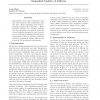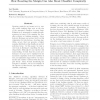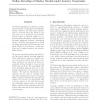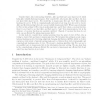ICML
2006
IEEE
15 years 7 days ago
2006
IEEE
Ingcreasingly, data-mining algorithms must deal with databases that continuously grow over time. These algorithms must avoid repeatedly scanning their databases. When database att...
ICML
2006
IEEE
15 years 7 days ago
2006
IEEE
We propose a new model for the probabilistic estimation of continuous state variables from a sequence of observations, such as tracking the position of an object in video. This ma...
ICML
2006
IEEE
15 years 7 days ago
2006
IEEE
Reinforcement learning (RL) was originally proposed as a framework to allow agents to learn in an online fashion as they interact with their environment. Existing RL algorithms co...
ICML
2006
IEEE
15 years 7 days ago
2006
IEEE
Boosting methods are known not to usually overfit training data even as the size of the generated classifiers becomes large. Schapire et al. attempted to explain this phenomenon i...
ICML
2006
IEEE
15 years 7 days ago
2006
IEEE
In machine learning problems with tens of thousands of features and only dozens or hundreds of independent training examples, dimensionality reduction is essential for good learni...
ICML
2006
IEEE
15 years 7 days ago
2006
IEEE
We present the first large-scale empirical application of reinforcement learning to the important problem of optimized trade execution in modern financial markets. Our experiments...
ICML
2006
IEEE
15 years 7 days ago
2006
IEEE
Knowledge-based planning methods offer benefits over classical techniques, but they are time consuming and costly to construct. There has been research on learning plan knowledge ...
ICML
2006
IEEE
15 years 7 days ago
2006
IEEE
The structure of a Bayesian network (BN) encodes variable independence. Learning the structure of a BN, however, is typically of high computational complexity. In this paper, we e...
ICML
2006
IEEE
15 years 7 days ago
2006
IEEE
The Viterbi algorithm is an efficient and optimal method for decoding linear-chain Markov Models. However, the entire input sequence must be observed before the labels for any tim...
ICML
2006
IEEE
15 years 7 days ago
2006
IEEE
Consider Alice, who is interacting with Bob. Alice and Bob have some shared secret which helps Alice identify Bob-impersonators. Now consider Eve, who knows Alice and Bob, but doe...




